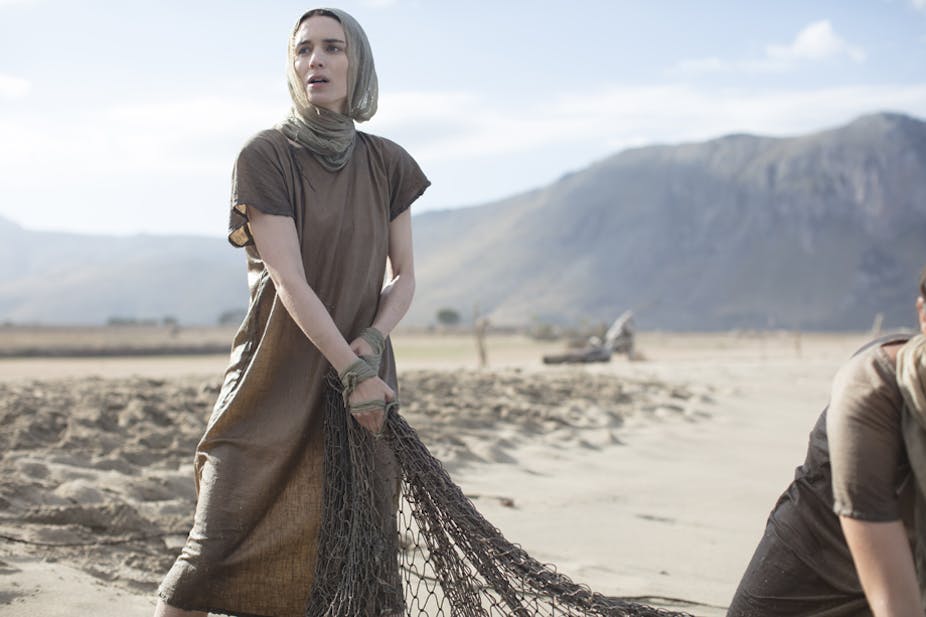Rooney Mara, the star of this Easter’s biblical epic Mary Magdalene, complained bitterly in 2015 about her role in the Hollywood whitewashing controversy surrounding Joe Wright’s film Pan.
In Pan, Mara – who is white – played Native American character Tiger Lily, a casting decision which drew sharp criticism and over 96,000 signatures in a petition protesting the whitewashing of the film. In an interview with The Telegraph, Mara lamented:
I really hate, hate, hate that I am on that side of the whitewashing conversation. I really do. I don’t ever want to be on that side of it again. I can understand why people were upset and frustrated.
And yet here we are. Mary Magdalene is the latest in a long line of Hollywood-produced biblical films to whitewash its cast. The classic biblical epic The Ten Commandments kicked off the trend in the 1950s. More recently, Ridley Scott’s biblical blockbuster Exodus attracted widespread criticism and a social media boycott campaign for having a white cast.
While Mary Magdalene’s director, Garth Davis, avoids being as boorish as Scott, who infamously told Exodus boycotters to “get a life” in his response to whitewashing allegations, he still managed to sidestep the issue, saying:
For me, the most critical, important thing was that I made the most emotionally compelling Mary and Rooney just has such a unique quality. She has an otherworldliness, and in her silences – there’s no other actress like her – she just creates these universes. And all of that was just so critical in bringing to life Mary’s character, so I felt that I had to choose that.
Nevertheless, the Mary Magdalene film is troubling for its lack of diversity. While its portrayal of Judas, played by Tahar Rahim – who is of French Algerian descent – might seem to be a positive development from previous popular cultural representations of the character, there are other problems, too.
White Jesus
Jesus is also played by a white actor: Joaquin Phoenix. Phoenix is a talented performer, but his Christ delivers lines as if he’s stoned and mansplains forgiveness to women who express anger about rape and femicide – a particularly galling scene given the film’s links with Harvey Weinstein (Weinstein’s company was the film’s US distributor) and that it’s been hailed as a feminist film. Alongside Mara, whose complexion often matches her cream outfits, the whiteness of the actors in the film is startling.

Stranger still is the bizarre, and seemingly unnecessary, array of accents in the film. While the white leads, Phoenix and Mara, get to speak in their natural American notes, other characters, such as the main black actor Chiwetel Ejiofor, who plays Peter, affect a variety of accents. Ejiofor – who has won a flurry of awards, including a best actor Oscar for 12 Years A Slave, over the years – swaps his natural English accent for a generic “African” accent. This proves to be a problematic move.
Clearly, given his natural speaking voice, Ejiofor’s African accent in the film is a deliberate directorial choice. If being African was an essential part of the characterisation of Peter, then one wonders why Davis didn’t just hire an African actor. As it stands, it’s strikingly peculiar in the film that Ejiofor puts on an accent while others – the lead white actors – do not.
Unfortunately, Peter’s faux-African accent tends to signify negative racial and ethnic stereotyping in the film. Peter repeatedly proves himself to be the misogynist in the apostle group. While the other apostles embrace Mary Magdalene and, in the case of Judas, become her friend, Peter remains as hostile to Mary at the end of the film as he is at the start.

Misogynist?
In the scene when Mary leaves her family to join the apostles, Peter says that she will divide them, a sentiment he repeats in their final scene together (an episode borrowed from The Gospel of Mary) when, after she is the first apostle to witness the resurrected Jesus, he tells her that she has “weakened” the group.
In another scene where Peter and Mary come across a town ransacked by Romans, Mary rushes to the aid of the starving and suffering inhabitants. Peter, however, tells an appalled Mary that they don’t have time to help. The character of Peter, then, is in danger of portraying black African men as regressive, misogynistic and self-serving.
Despite the assurances of Davis that the whitewashing of the Mary Magdalene movie was merely a side effect of making the best casting choices, the film remains troubling in its representations of race.
Mara may well hate being on the wrong side of such controversies but while Hollywood fails to take seriously racial and ethnic representations, then the dubious tradition of whitewashing in its films will continue.

